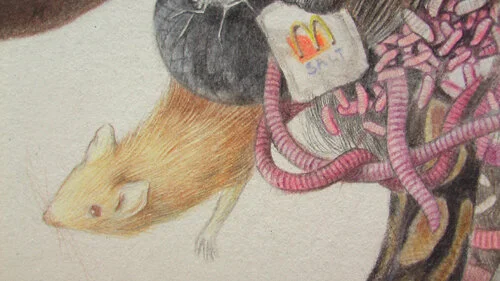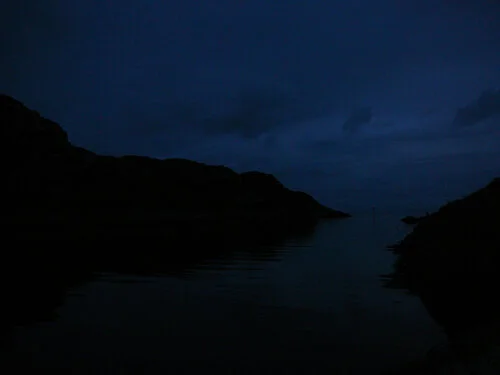Dates: March 5 – 8, 2009
Hours: March 5, 10 am – 10 pm; March 6 – 8, 10 am – 6 pm
VIP reception: Thursday, March 5, 7pm-10pm.
Performances by Rishaug vs. Watz
Monica Winther & Kjersti Vetterstad
Location: 217 East 42nd Street, New York, NY. Between 2nd and 3rd Avenues
Subway: 4,5,6,7, S to Grand Central Station
Bus: M104 & M42 to Third Ave; M101, M102, M103, M15 to 42nd Street
DARKNESS DESCENDS: Norwegian Art Now delves into the uniquely Norwegian style of neo-romanticism in contemporary art. The exhibition will bring together a multi-generational group of visual, performance, sound, and video artists to explore a fascination with darkness that is inspired by mythology and a close relationship to nature. Curated by Christina Vassallo, the exhibition will take place during The Armory Show, March 5 – 8, 2009. DARKNESS DESCENDS is the fourth installment in a series of M*A*S*H shows produced by Cottelston Advisors to coincide with major art fairs.
Artists: Thora Dolven Balke, Ole Martin Lund Bø, Halvor Bodin, Marianne Hurum, Anki King, Ingvild Langgård, Sverre Malling, Are Mokkelbost, Trine Lise Nedreaas, Rune Olsen, Alexander Rishaug, Elise Storsveen, Kjersti Vetterstad, Kira Wager, Marius Watz, Jana Winderen, Monica Winther, and Munan Øvrelid.
The sound art program of DARKNESS DESCENDS will be presented simultaneously at PULSE New York.
Christina Vassallo is an independent curator based in New York City.
Michael Sellinger created Cottelston Advisors to provide art advisory and exhibition production services.
Generous support for the exhibition has been provided by the Royal Norwegian Consulate General. Beverages provided by Christiania Vodka.
For more information, please contact: Michael Sellinger, 917-514-7007, msellinger@cottelston.com or go to www.cottelston.com.
101 West 23rd Street, Suite 4P New York, NY 10011
msellinger@cottelston.com www.cottelston.com 917.514.7007

































Curator’s essay by Christina Vassallo
The space that contemporary art occupies in the cultural identity of Norway is currently in flux. There is turbulence beneath the polished and exalted heritage that national icons such as Henrik Ibsen and Edvard Munch have left behind—a turbulence that fuels the transmission of new ideas and gives rise to creative conflicts. Many young Norwegian voices emerging today reject Modernist ideals and are united through their interest in artistic eclecticism, showing a wider range of perceptions than their predecessors. Whether they rely on local channels to distribute their work or participate in the international art scene, there remains a strong adherence to the fantastic, rooted in the tradition of folktales and mythology that is often expressed with a dark undercurrent.
The Norwegian art scene expresses dichotomies that exist in the larger context of Norwegian society. The harshness of the landscape provides a clear example; the country's newfound cosmopolitan nature is an unlikely consequence of its geographic insularity. So too is the existence of extreme subcultures that thrive in a peace-building nation known for the serene natural beauty of its fjords, mountains, and valleys. These juxtapositions have imprinted much of today’s artistic practice, where melding the challenges of reality with the shadowy beauty of irrational phenomena is almost a national coping mechanism.
The sound art program of the exhibition describes an interest in affecting mood through the overwhelming beauty and ominous characteristics of nature. In Submerged Jana Winderen evokes fear in the listener by manipulating the environmental noises she collected with underwater microphones of glaciers melting in the North Sea. The intrusive arm of the sea also appears in Thora Dolven Balke’s The Wave, where the banal chore of grooming is disrupted and finally drowned out by sounds of nature. At first wind and water flit in and out of the soundscape like poltergeist but they eventually take over to confirm humankind’s fear of uncontrollable nature. The slow and eerie OK, Bear Hymn #1 by Are Mokkelbost is a creation myth told through sine waves, in which gradual changes in volume and pitch construct a primitive forest—the perfect setting for transformation. In Lumen Ingvild Langgård translates Dante's medieval epic poem of the journey through Heaven, Hell, and Purgatory into bird song; the crescendo is a terrifying layering of frantic squawks and screeches.
Folklore and mythological symbolism also loom heavily throughout the exhibition, creating a space for a fantasy realm. Monica Winther & Kjersti Vetterstad’s performance piece, Daughters of Valhalla, is based on Völuspá, the Norse poem that describes the beginning and end of the world. On stage the artists assume the persona of contemporary soothsayers foreshadowing the decline of modern civilization. In their performance and in their film Battle, which celebrates the aesthetics of the death metal musical genre and fantasy movies, the artists refer to a persistent pre-packaged version of Norwegian culture from Viking times through the present.
Fascinated by the variety of fanatical obsessions Trine Lise Nedreaas interviewed Father Sebastian (former head of the Sanguinarium Vampyre Society) for her film Testify. In his pedagogic monologue, the vampiric leader discusses the blind faith required to be a true believer. Nedreaas’ portrait of a cult figure underscores the prevalence of a common thread in much of the art coming out of Norway today: the critique of power structures. Ole Martin Lund Bø’s large-scale aerial photographs of Norwegian churches refer to the visual rhetoric of power by reducing the authoritarian elements in religious architecture. Lund Bø alters our perception of the relationship between churches and their surroundings by avoiding the representation of their most imposing angle, where the spire towers over the visual field. The squares and rectangles of the nave are completely flattened, but the visual experience conjures recognition of the structure’s purpose in the viewer, indicating its mark as a signifier on human consciousness. A neo-gothic visual can also be seen in the drawings of Sverre Malling and Halvor Bodin and in Elise Storsveen’s collages. The matter that crawls out of the artist’s head in Malling’s self-portrait turns the subject into a Medusa figure, whose macabre inner thoughts are materialized as liberated vermin. Bodin’s pencil drawings are based on CAT scans of his father’s brain after a stroke, adding sinuous form to an internal fear of what may be the inevitable. Storsveen’s collages depict haunted landscapes where fear and confusion reign beneath the alluring beauty of abandoned places. The remaining artists in the exhibition— Marianne Hurum, Anki King, Alexander Rishaug, Kira Wager, Marius Watz and Munan Øvrelid—also illustrate these conceptual threads.
DARKNESS DESCENDS is not intended as a definitive account of the state of contemporary Norwegian art, but rather as a forum to display a variety of expressions stemming from the same cultural roots. The exhibition presents a cross-section of artistic currents that are unfolding in the Norwegian scene, often based in deeply subjective experience but nonetheless maintaining qualities of universal relevance.
